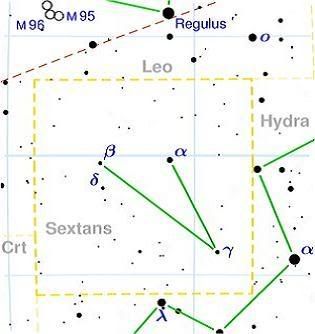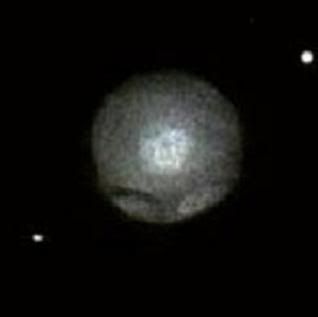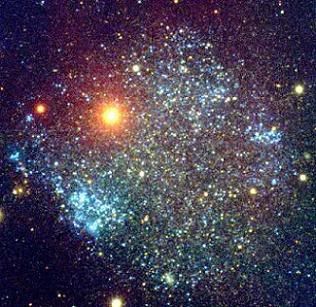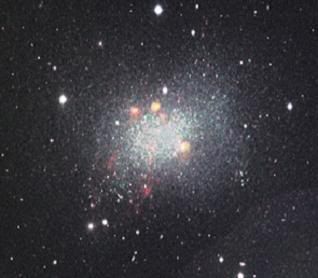Post by glactus on Feb 17, 2008 5:24:35 GMT

A minor constellation of Sextans is positioned just south of Leo. The constellation had been established by Hevelius in 17th century, formed from fine stars with 4th or 5th magnitude. The Sextans constellation has a celestial territory of a true square and the celestial equator is crossing through the constellation. There are some galaxies of note as well as interesting star systems.
Notable stars:
Gamma Sextantis - A, B and C.
Gamma Sexantis (y Sextantis) is a triple star system approximately 262 light years from Earth. The combined apparent magnitude of the system is 5.07. This system is composed of a close binary star, Gamma Sextantis A and B, which is given the stellar classification A1. The two component stars are approximately 0.38 arcseconds apart, or approximately 30 Astronomical Units, and have apparent magnitudes of 5.8 and 6.2. They complete one orbit every 77.6 years. Orbiting the binary star, at a distance of 36 arcseconds, roughly a hundred times farther out, is Gamma Sextantis C, a 12th magnitude companion.
LHS 292
LHS 292 is a red dwarf star in this constellation. This star is far too faint to be seen with the unaided eye, although it lies relatively close to our Sun at a distance of about 14.8 light years. It is a flare star, which means it can suddenly increase in brightness for short periods of time. Magnitude is 15.6
Notable objects:

NGC 3169
NGC 3169 together with NGC 3166 make a very pretty pair of galaxies. They are truly near to one another and affect each other's structure. Most notably it appears that NGC 3166 has quieted down in terms of star formation; while NGC 3169 continues to produce new stars as indicated by the bluish spiral arms and pink star forming regions. NGC 3169 and 3166 are separated by a mere 50,000 light years - half the diameter of our own galaxy. These galaxies are of 11th manitude and dance some 60 million light years in the distance.

NGC 3166
In conjunction with the above NGC 3169, This galaxy is the other one of the pair, and both lay at the northern field of Sextans. A left one (eastern galaxy) is NGC 3169 and a right galaxy (western one) is NGC 3166, two galaxies are about 7 arc minutes apart. Both galaxies are compact spirals having diameters of 5 arc minutes.

UGCA 205 - Sextans A
Sextans A ( as known as UGCA 205 ), is a tiny dwarf irregular galaxy within the local group with a span of 5,000 light-years. It is at a considerable distance, being 4.31 million light years from Earth with redshift at 324 km/second. The galaxy is undergoing prolific starbirth at the present time. Magnitude is 11.9.

UGC 5373- Sextans B
UGC 5373, is an irregular galaxy with no spiral arms that is part of the Local Group. Type Lr-IV-V, Sextans B lies 4.44 Million light years from Earth, and thus is one of our most distant members. The redshift count is 300 km/second, and magnitude 11.9.

skywatch
credits:
Sextans map: Wikipedia
en.wikipedia.org/wiki/Sextans
image: NGC3169
atunivers.free.fr/virgo/galgrps/img_ggp/ngc3169.jpg
image NGC 3166
www.andreas-domenico.de/deepsky/N3166.html
image: Sextans A AUGC 205
en.wikipedia.org/wiki/Sextans_A
image: UGC 5373 Sextans B
www.answers.com/topic/sextans-dwarf-spheroidal


